By Nicole Golden
RESEARCH REVIEW
Effects of Selected Rehabilitative Exercises on External Rotator Muscles and Trapezius Muscles of Masonry Workers
STUDY AUTHOR
Singh, G. K., Srivastava, S., Kumar, M., & Ratnakar, S.
ORIGINAL CITATION
Singh, G. K., Srivastava, S., Kumar, M., & Ratnakar, S. (2018). Effects of selected rehabilitative exercises on external rotator muscles and trapezius muscles of masonry
workers. Work, 60(3), 437–444. https://doi.org/10.3233/wor-182757
INTRODUCTION
The study examines the effectiveness of three key exercises commonly used to strengthen/rehabilitate dynamic shoulder stability. Shoulder injuries and degeneration are common in individuals who perform overhead work due to repeated stress on the tendons without proper dynamic shoulder stabilization (Cruz et al., 2015).
Furthermore, it was shown that the infraspinatus, subscapularis, and supraspinatus muscles are all prone to age-related degeneration though the teres minor appears to be spared from this phenomenon (Raz et al., 2015). This study’s premise is that a common cause of shoulder injury is an overall underactive rotator cuff and poor rotator cuff synergy.
Similarly, it outlines the importance of the infraspinatus’s proper function and teres minor in maintaining proper humeral alignment (Singh et al., 2018). The three critical exercises examined are prone horizontal abduction at the shoulder, side-lying external rotation, and standing abduction with 90-degree elbow flexion.
STUDY SUMMARY
PARTICIPANTS
This case study had a sample size of 10 participants (n=10). All prospective participants were given a questionnaire for study inclusion, which required that participants (1) have worked in Masonry for more than four years, (2) reported a medium to high pain frequency and duration in the shoulder, (3) were male, (4) were otherwise deemed healthy.
All subjects were similar in terms of weight, height, age, and BMI with the ages of the workers being 35±9.94 years, with an average of 12.90±8.88 years’ experience, with an average weight of 59.4±9.10 kilograms, the height of 168.10±3.51 centimeters, and average BMI of 20.95±2.63.
METHODS
The participants were fitted with a device to collect EMG readings and perform a trial of each exercise. The normalized iEMG value of each muscle is expressed as a percentage of maximum voluntary contraction (MVC). Each of the muscles – Infraspinatus (IS), Teres minor (TM.), Upper Trapezius (UT), Lower Trapezius (LT), Middle Trapezius (MT), Posterior Deltoid (PD) are measured independently.
Additionally, muscle synergy within specific muscle groups was also measured. Rotator Cuff (RC) synergy was the average MVC of the IS and TM. The trapezius (TRAP) synergy was recorded as the average of all the readings in the
trapezius muscle group (UT, LT, MT). The external rotator (ER) synergy was determined as the average MCV reading of the IS, TM, and PD. The total shoulder synergy was reported as the average MCV reading of the ER and TRAP synergies.
Lastly, when determining the UT’s activity level versus the MT and LT, the MVC ratio of UT/LT and UT/MT was calculated. If the value was less than 100, it was determined that the UT activity was inferior to the MT and LT activity. If the reverse was true, it was determined that the UT had a higher activity level than the MT and LT.
RESULTS
Comparison of the activity of the trapezius group upper trapezius (UT), lower trapezius (LT), middle trapezius (MT), posterior deltoid (PD), infraspinatus (IS) and teres minor (TM ), and muscle synergies (TRAP group, ER group and TS synergy for each exercise are as follows (as expressed in a percentage of maximum voluntary contraction or MVC.
The exercises evaluated are comparable to the prone Blackburn T, standard side-lying external rotation, and shoulder level external rotation as described by the National Academy of Sports Medicine Blog post discussion shoulder rehabilitation exercises (Cruz, 2015).
Exercise 1: (Prone horizontal abduction- comparable to the prone Blackburn T)
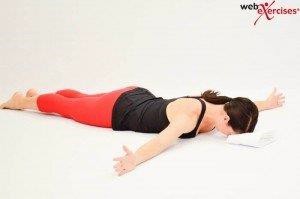
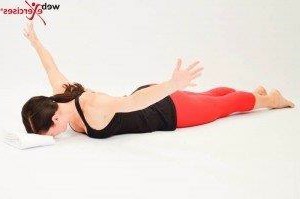
*Expressed as a percentage of Maximum Voluntary Contraction (MVC)
MUSCLE ACTIVITY
| UT | MT | LT | PD | IS | TM |
| 52.31±10.54 | 68.21±17.93 | 60.13±16.62 | 41.37±22.97 | 51.06±10.54 | 38.75±11.31 |
MUSCLE SYNERGIES
| TRAP | ER | RC | TS |
| 60.22±8.97 | 43.73±9.30 | 44.90±6.06 | 51.97±8.26 |
Exercise 2: (Side-lying external rotation)
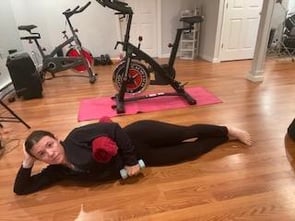
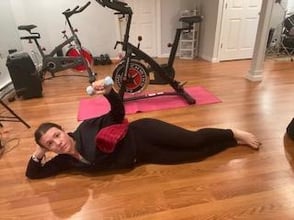
*Expressed as a percentage of Maximum Voluntary Contraction (MVC)
MUSCLE ACTIVITIES
| UT | MT | LT | PD | IS | TM |
| 38.17±22.78 | 35.52±7.43 | 35.12±6.03 | 26.81±7.06 | 39.48±9.33 | 33.79±6.57 |
MUSCLE SYNERGIES
| TRAP | ER | RC | TS |
| 36.42±9.91 | 33.36±3.07 | 36.64±6.05 | 34.89±5.60 |
Exercise 3 (Standing external rotation with 90 degrees of elbow flexion)
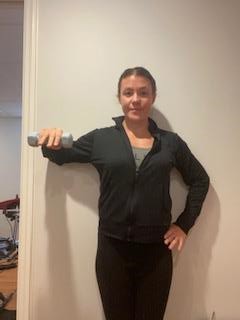
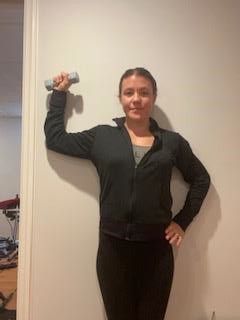
*Expressed as a percentage of Maximum Voluntary Contraction (MVC)
MUSCLE ACTIVITY
| UT | MT | LT | PD | IS | TM |
| 37.38±7.13 | 38.03±10.92 | 30.62±7.73 | 28.61±4.13 | 38.70±9.98 | 56.54±16.32 |
MUSCLE SYNERGIES
| TRAP | ER | RC | TS |
| 35.34±5.20 | 41.28±7.80 | 47.62±12.04 | 38.31±5.0 |
KEY FINDINGS
- Exercises 1 and 3 result in a higher overall rotator cuff synergy.
- Exercise 3 has the lowest posterior deltoid activity. The posterior deltoid is often synergistically dominant over the other external rotators, which can be problematic as it will downregulate the neural drive to the other external rotators resulting in underactivity and increasing the potential for injury (Forbush et al., 2018).
- Exercise 1 results in the higher middle and lower trapezius activity than the upper trapezius.
- The middle and lower trapezius are often underactive, especially with respect to the arms fall forward movement compensation (Clark et al., 2014). Similarly, an overactive upper trapezius is common and contributes to the forward head position compensation and shoulder dyskinesis (Kang et al., 2018). Exercises that favor the upper trapezius should be avoided in clients with these compensations.
- Exercise 3 resulted in the greats activation of the teres minor, which is often resistant to age-related deterioration and can help to compensate for other weakened external rotators (Raz et al., 2015).
CLINICAL APPLICATION
Rotator cuff stabilization exercises can be particularly beneficial for overhead athletes who may develop weakness in the external rotators. However, they can also be used as an injury prevention strategy for other types of clients (Cools et al., 2015).
It is quite common to encounter middle-aged or elderly clients who have significant shoulder pain, which, upon assessment, is determined to be stemming from shoulder instability and oftentimes an underactive or damaged rotator cuff.
Similarly, it has been demonstrated that the elderly population often suffers from age-related degeneration of most of the RC muscles (with the exception of the TM), and effective rehabilitative exercises in this population are always needed even in those without a history of frank injury (Raz et al., 2015).
It is advisable to incorporate rotator cuff stabilization exercises in phase 1 (stabilization endurance) and phase 2 (strength endurance) and continue to do so as your client moves through their macrocycle (Clark et al., 2014). This practice can help prevent underactivity in the external rotators and prevent injuries.
The small study conducted by Singh et al. (2018) provides a framework by which to judge the efficacy of specific shoulder stabilization exercises based on a client’s specific movement dysfunction or history of injury. It can help the fitness professional decide on which of these exercises is appropriate to incorporate into their client’s programming.
STUDY LIMITATIONS
The study design was simple and allowed for direct measurement and calculation of specific muscle activation based on an exercise. This can give the reader some guidance on programming for their client with respect to a shoulder stabilization exercise.
However, this study’s apparent limitation is that it is a small sample size (n=10). A larger-scale study would be needed to validate the results of this study (Faber & Fonsceca, 2014).
The study was also conducted in New Delhi, India, and only included workers from that region. The specific demands of the job were not well described, and working conditions unknown. It may be beneficial to conduct a study that included masonry workers from other regions with different working conditions.
Similarly, it would be beneficial for a future study to include females, athletes, or individuals with other types of jobs that require overhead work (i.e., carpenters, painters, etc.).
Further study would be required to assess the true effectiveness of these types of exercises in the powerlifting and/or bodybuilding population. It would also be beneficial to test the effectiveness of these exercises in preventing RC tears in the CrossFit population, where shoulder injuries are extremely common.
In fact, in a cohort of Dutch CrossFit athletes, it was demonstrated that 56.1% of them sustained injuries, with 87% of those injuries affecting the shoulder (Mehrab et al., 2017).
CONNECTION TO PRACTICE AS A NASM CERTIFIED PERSONAL TRAINER
Corrective exercise based on a comprehensive movement assessment is critical for the ultimate success of any client and plays an important role in injury risk reduction.
New clients, even those without complaints of shoulder pain, should be screened for shoulder instability with the OHSA; however, more specific assessments can be included in initial and follow-up assessments.
To elaborate, glenohumeral joint external rotation range of motion assessment, in addition to a standing overhead dumbbell press assessment, pull test, abduction, rotation, and shoulder rotation test as described in the NASM CES course, can be extremely useful in detecting shoulder instability before symptoms (i.e., pain) occur (Clark et al., 2014).
Cruz et al. (2015) described that the Blackburn T Scapular retraction is one of the most effective exercises available to assist in stabilizing and strengthening the RC. Blackburn T Scapular retraction is an effective exercise for this population.
However, standing exercises help reduce the activity of the PD, which is synergistically dominant over the other ER in the case of this population. Therefore, it is advisable to incorporate a variety of RC strengthening exercises in a client’s programming.
The prime movers such as the deltoids, pectoralis major/minor, latissimus dorsi, and teres major are over trained in this population, and the stabilizing muscles (i.e., infraspinatus and teres minor) are often underactive and unable to handle the demands of high volume training. Similarly, poor posture from sedentary work coupled with a forward head position can further contribute to shoulder instability (Mehrab et al., 2017).
These injuries can often be prevented with the inclusion of periodic stabilization and/or corrective exercises (such as the ones described in the referenced article) to improve dynamic stability in the shoulder amongst other areas of the body as part of a client’s regular programming.
For instance, clients training in higher phases of the strength level of the OPT model (i.e., hypertrophy and maximum strength) will benefit from periodized programming, including transitioning the client back to strength-endurance or even stabilization-endurance periodically as part of their macrocycle.
It can be useful to screen these clients for shoulder instability prior to creating programming in these phases and using these exercises to prevent injury to the shoulder (Clark et al., 2014). This study can provide some guidance as to which specific exercises are most appropriate to program for a client’s individual needs.

![REHAB EXERCISES FOR MASONRY WORKERS [RESEARCH ARTICLE REVIEW]](https://opstudiohk.com/wp-content/uploads/2020/10/masonry-worker.jpg)